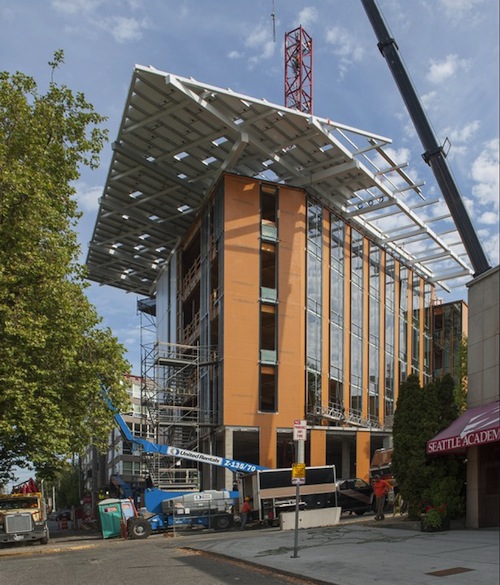Seattle’s Bullitt Center, a project of the Bullitt Foundation, has been designed to be the most energy efficient commercial building on the planet and put Seattle on “the forefront of the green building movement,” according to the project’s website.
With the first floor already leased to the International Living Future Institute and the University of Washington Integrated Design Lab, the remaining five floors of this 50,000-sf green building are now available to lease in advance of its planned opening this spring.
The Bullitt Center expects to achieve the goals of the Living Building Challenge (v2.0), the world’s most strenuous sustainability benchmark. Certification requires a structure to be energy and water self-sufficient for 12 consecutive months and meet 20 imperatives within seven “Petals,” or performance areas.
Petal One – Site: The location supports lifestyle that is friendly to pedestrians, bicycles, and public transit.
Petal Two – Water: Rainwater is collected on the roof and stored underground to be used building-wide.
Petal Three – Energy: The solar array will produce sufficient electricity for the building’s tenants.
Petal Four – Health: Promoting health for the building’s occupants, it features stairways that are pleasing alternatives to elevators, operable windows, and facilities that encourage occupants to walk and share resources.
Petal Five – Materials: The Bullitt Center will not contain hazardous materials from the “Red List,” such as PVC, lead, cadmium, mercury, or hormone-mimicking substances.
Petal Six – Equity: Fresh air and daylight will be available to all workers and the construction team has been selected using the Community High Road Agreement as enacted by the city of Seattle.
Petal Seven – Beauty: The architecture has been designed to help beautify the surrounding area, including a green roof, large structural timbers, native plants, an innovative photovoltaic array, and a revitalized neighboring pocket park.
The Building Team for the $30 million facility includes architect Miller Hull Partnership and contractor Schuchart, as well as Point32, PAE Consulting Engineers, Luma Lighting Design, 2020 Engineering, and Berger Partnership.
(http://www.jetsongreen.com/2013/03/the-worlds-greenest-commercial-building-now-leasing-for-spring-2013-opening.html)
Related Stories
| May 18, 2011
Carnegie Hall vaults into the 21st century with a $200 million renovation
Historic Carnegie Hall in New York City is in the midst of a major $200 million renovation that will bring the building up to contemporary standards, increase educational and backstage space, and target LEED Silver.
| May 17, 2011
Redesigning, redefining the grocery shopping experience
The traditional 40,000- to 60,000-sf grocery store is disappearing and much of the change is happening in the city. Urban infill sites and mixed-use projects offer grocers a rare opportunity to repackage themselves into smaller, more efficient, and more convenient retail outlets. And the AEC community will have a hand in developing how these facilities will look and operate.
| May 17, 2011
Architecture billings index fell in April, hurt by tight financing for projects
The architecture billings index, a leading indicator of U.S. construction activity, fell in April, hurt by tight financing for projects. The architecture billings index fell 2.9 points last month to 47.6, a level that indicates declining demand for architecture services, according to the American Institute of Architects.
| May 17, 2011
Sustainability tops the syllabus at net-zero energy school in Texas
Texas-based firm Corgan designed the 152,200-sf Lady Bird Johnson Middle School in Irving, Texas, with the goal of creating the largest net-zero educational facility in the nation, and the first in the state. The facility is expected to use 50% less energy than a standard school.
| May 17, 2011
Gilbane partners with Steel Orca on ultra-green data center
Gilbane, along with Crabtree, Rohrbaugh & Associates, has been selected to partner with Steel Orca to design and build a 300,000-sf data center in Bucks County, Pa., that will be powered entirely through renewable energy sources--gas, solar, fuel cells, wind and geo-thermal. Completion is scheduled for 2013.
| May 17, 2011
Should Washington, D.C., allow taller buildings?
Suggestions are being made that Washington revise its restrictions on building heights. Architect Roger Lewis, who raised the topic in the Washington Post a few weeks ago, argues for a modest relaxation of the height limits, and thinks that concerns about ruining the city’s aesthetics are unfounded.
| May 17, 2011
The New Orleans master plan
At an afternoon panel during last week's AIA National Conference in New Orleans, Goody Clancy Principal David Dixon and Manning Principal W. Raymond Manning shared their experiences creating the New Orleans Master Plan, a document that sets a new course for the city, from land use and transportation planning to environmental protection.
| May 17, 2011
Do these buildings look like buffalo to you?
It’s hard to contemplate winter now that we’re mid-spring, but when the seasons change, ice skaters in Winnipeg will be able to keep warm in plywood shelters designed by Patkau Architects. The designers created temporary shelters inspired by animal behavior—specifically, buffalo bracing against the wind. Check them out.
| May 16, 2011
USGBC and AIA unveil report for greening K-12 schools
The U.S. Green Building Council and the American Institute of Architects unveiled "Local Leaders in Sustainability: A Special Report from Sundance," which outlines a five-point national action plan that mayors and local leaders can use as a framework to develop and implement green schools initiatives.












